
A strategic approach to career development: maximizing chances for job fulfillment.
Disclaimer: opinion of the author, not the opinion of the company she works for.
About the Author
Liliya is a senior product manager with 10 years of experience working in different company sizes — startups, SMBs, and enterprises, across B2B and B2C business models in different industries: data, travel, media, etc. She worked in 4 different countries and now is a Sr. PM in a big tech company in the Bay Area, California, USA.
Introduction
Earlier in my career journey I was approaching career development on an intuitive level, however, I soon realized that to succeed just a skillset vs. job requirements match is not enough. So in this article, I’ll try to answer: How to increase our chances to thrive in a career?
A career journey is not a one-size-fits-all scenario. Some individuals are happy in large organizations and some are happy in smaller companies too, I’ve seen the opposite too. So how to know what will work better for you? From my perspective, it varies depending on multiple factors. Let’s figure out together — how we can maximize our chances for happiness in the workplace.
Step 1. Paradigm Enhancement
Self-assessment
Below you can see an example of the skills self-assessment wheel for PM, designer, and Developer:

This is an abstract example, but let’s discuss how it works.
Along the edge of the wheel, we have different skills for given roles — for instance, for PM we have:
- execution,
- data literacy,
- market acumen,
- strategy, etc.
The center of the wheel is connected to each of the skills with a line — in the wheel center we have 0 score, and where the line connects to the edge of the wheel we have 10. Thus the person who does the self-assessment decides how well s/he is in the skill and rates her/himself accordingly.
In this example, we can see that PM is very well with the Execution — thus a 10/10 score, however, needs improvement in Feedback Synthesis, as it’s below 5.
Self-reflection
I propose to use an identical approach to evaluate how different parameters of the workplace itself resonate with your values. Therefore, instead of putting the skills, put value s along the wheel edge. Then rate each value based on importance for you — 10 being most important and 0 being not important at all. Example of values:
- Work-life balance
- Opportunities for growth
- Recognition
- Supportive manager
- Etc.
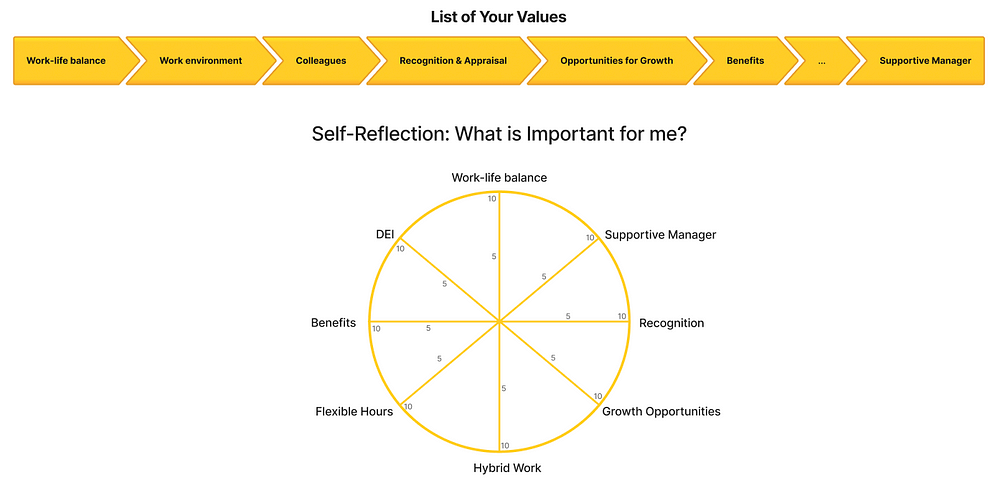
Note: that your expectations and values will probably change in the different stages of your life, so reevaluate when needed.
By understanding what is important for you on the values level and what are your strongest skills for the role, you’ll be more equipped to make the right call when it comes to choosing your next career opportunity.
Step 2: Business model, company maturity, size, domain

Naturally, all of us have different interests, so we’ll be gravitating toward certain industries. Knowing where your interests lie will also help with your longevity and happiness in any given company since you’ll spend at least 40h/week which is ~62.5% of your non-sleep weekdays (excluding weekends) on work.
For example, I’m interested in data and I get a lot of fulfillment from working in this domain. On the contrary, right now my values do not align with tobacco production companies, so I can’t imagine working in that domain for myself.

Company size will also impact the work environment:
- Large companies can usually provide more stability, however, you’ll have to deal with a lot of negotiations, as most likely there will be significant cross-team collaboration since one area can be owned by multiple teams. Therefore alignment and agreements are needed.
- For smaller companies, you are more likely to avoid company politics, at the same time, you’ll be most likely constrained with resources and the pace will be aggressive.
Now let’s discuss the business models & nuances of working there:
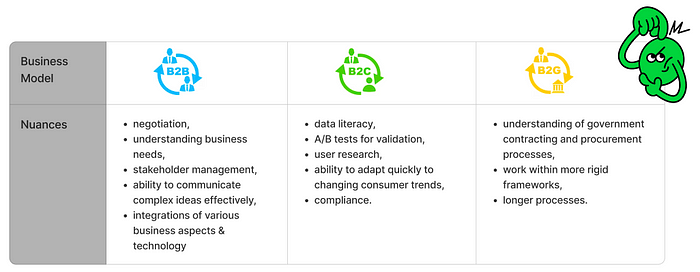
- B2B refers to Business to business and in such a model a company is offering products or services to other businesses, i.e. other businesses are your customers. For example, Atlassian — among other things offers software for project management to other companies to run their processes.
- B2C refers to Business to consumer For example, Spotify — a streaming service for individuals to listen to music/podcasts.
- B2G refers to business to government. Example — Palantir empowers intelligence agencies (US Department of Defense) to securely derive actionable insights from sensitive data and achieve their most challenging operational objectives.
Finally, let’s discuss the work environment depending on product maturity and its impact on the work environment:

- 0→1 refers to products built from scratch.
- 1→∞ refers to incremental improvements to an existing product.
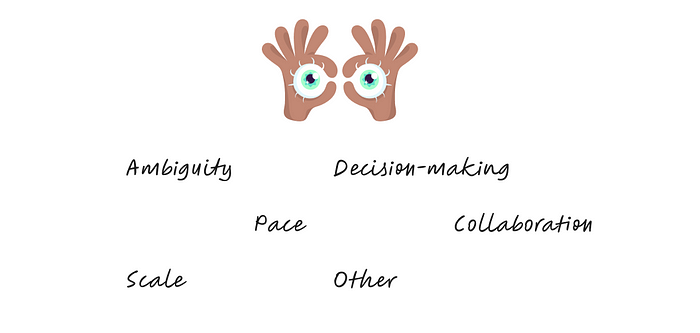
To conclude, company size, business model, and product maturity will have their nuances when it comes to the work environment. So you should evaluate your readiness for the expected levels of ambiguity, pace, collaboration, etc. Additionally, since work takes 62.5% of your non-sleep time (excluding weekends), finding and focusing on domains you are interested in will increase the chances of getting fulfillment from your work.
Step 3: Deep Specialisation vs. Broad Skillset
When making career decisions it’s helpful to realize that with current life expectancy and Social Security retirement age, we’ll spend ~40 years in the workforce. So it’s not uncommon that interests and career aspirations will change. Let’s look at some statistics:
- For people born in 1959 or later, the Social Security retirement age is now at 67.
- Baby boomers’ career change statistics in 2019 show that they held an average of 11.3 jobs between the ages of 18 and 46. Almost 50% of these jobs were before they turned 25. That puts their average job tenure at a little under 4.5 years.
Given the longevity and pivots of careers, an employee-type framework based on areas of expertise, skills across topics, and leadership could help understand the possibilities of expertise development:
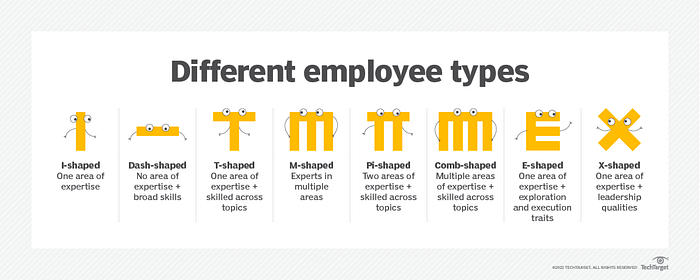
If we over-simplify it, there are two primary paths: specialist or generalist. See examples & a book recommendation from Bill Gates provided below:

There are pros and cons to being a specialist vs. a generalist professional.
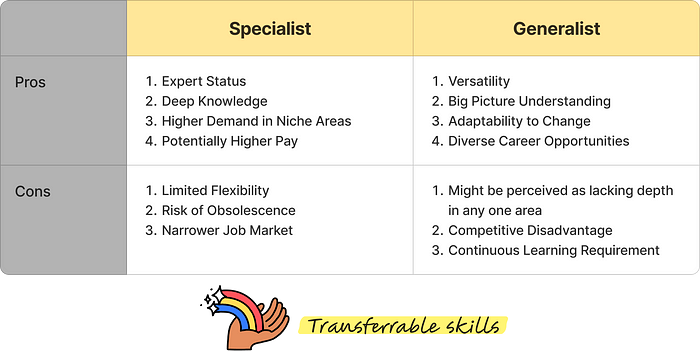
In the tech industry, the decision between specializing or developing a broad skill set is crucial for career growth. Specialists gain deep expertise and authority in a specific domain, making them sought-after in niche areas and often commanding higher salaries. However, they face limitations in job market flexibility and risk obsolescence if their skills become outdated. Conversely, professionals with a broad skill set adapt easily to various roles, offering a holistic view of projects and greater job market opportunities. This adaptability is valuable in a rapidly changing industry, but it may come at the cost of being perceived as less proficient in any one area. For tech professionals, choosing between specialization and breadth hinges on aligning personal interests, career goals, and the evolving demands of the tech landscape.
Concluding the specialist versus generalist debate, it’s wise to focus on developing transferable skills that provide flexibility and adaptability, ensuring that you remain valuable and agile in the ever-evolving landscape of the tech industry.
Step 4: Culture & why it is important
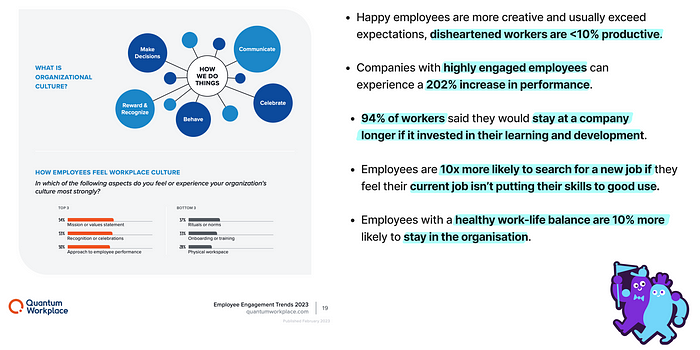
Considering a company’s culture is paramount when evaluating new career opportunities. A company’s culture encompasses its values, beliefs, behaviors, and the overall environment in which employees operate. It significantly influences job satisfaction, engagement, and, ultimately, one’s success in the role.
Aligning with a culture that resonates with your personal values and work style not only enhances day-to-day job fulfillment but also fosters long-term professional growth. In environments where there is a strong cultural fit, individuals are more likely to thrive, contribute meaningfully, and seize opportunities for advancement. Therefore, a thorough understanding and assessment of a company’s culture should be a critical component of any career decision-making process.
Conclusion
Navigating career development is a multifaceted journey and a one-size-fits-all approach does not apply to career growth. The importance of aligning personal values, skill sets, and interests with the right company environment cannot be overstated. Whether it’s choosing between a startup’s agility or an enterprise’s stability, a B2B or B2C model, or the thrill of 0→1 innovation versus the steady growth of 1→∞ products, each choice shapes career trajectory. The key takeaway is to remain adaptable, open to learning, and to continually align your career choices with your evolving professional and personal goals.
By focusing on transferable skills and being mindful of the cultural fit with potential employers, you position yourself not just for job success, but for job fulfillment — a crucial distinction in the long arc of a career.
Thank you for checking out my article. In the comments section below feel free to share your perspective or some other practices that helped you in your career development.
Resources
- Find a mentor on the Meander platform
- Join the Product School community for product managers
- Join Friends of Figma design community
- Read reviews from employees on Blind and Fishbowl
- Analyse salaries across companies on Levels.fyi
